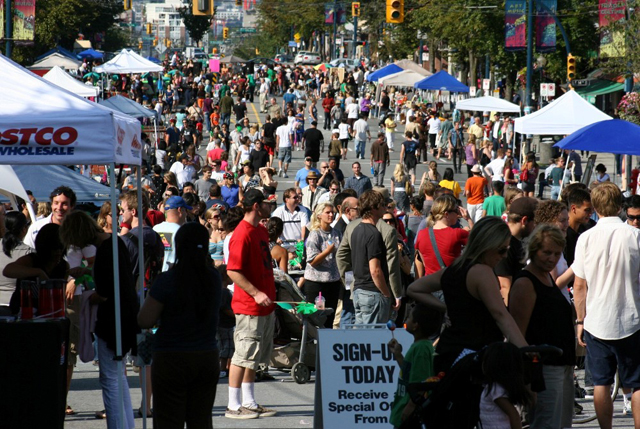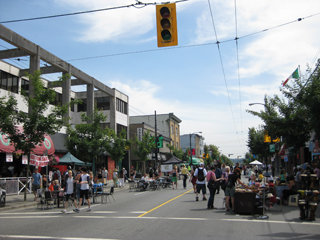Viva Vancouver
Viva Vancouver

Remember Robson Street during the 2010 Winter Olympics? Or maybe you’ve visited the numerous car-free streets of Strøget, Copenhagen, Denmark or the Cinque Terre in the Liguria region of Italy. These are all examples of streets not used for cars but for pedestrians, festivities and just hanging out. The City of Vancouver has been experimenting with shutting down streets for community purposes since 2009, and starting this weekend through to the end of the summer, you’re going to see a lot more of it.

Viva Vancouver is the department of The City of Vancouver mandated to:
- Create a variety of public spaces for a mix of engaging activities and sojourning
- Increase neighbourhood livability benefiting residents, businesses, community groups and visitors
- Encourage sustainable and active transportation by creating more safe and interesting spaces for walking and cycling
There’s a long list of events they have planned in different communities in Vancouver starting this weekend on Granville Street. Actually, Granville between Hastings and Smithe will be closed every weekend this summer. Here’s exactly when events will be going on there:
- Fridays after 9 p.m.
- All day Saturdays/Sundays/holidays
- All day Friday, July 15 and Friday, August 19
As noted in the June service changes, buses on Granville Street are being rerouted during Viva Vancouver event times.
Besides Granville Street, there are smaller events in other areas of the city like the Livable Laneway project on Main Street, a community artists plaza on Cambie Street and much more. Check out the spaces and activities section of the Viva Vancouver website for all the info.
I spoke with one of the coordinators of the events, Daniel Fortin, to find out more about Viva Vancouver.
How long has Viva Vancouver been in existence?
The brand was launched this summer. In 2009, there were summer spaces. And then there was the Olympic Pedestrian Corridors and Rediscover Granville in 2010. Viva Vancouver is sort of an amalgamation of these precursors with an aim to do this sort of thing into the future.
How many people work for Viva Vancouver?
There are five of us, although we draw on other City workers from other departments since there’s a lot of work to do.
Where does the money come from to pay for Viva Vancouver?
The money comes from a grant from the Vancouver 125 celebration, and the rest is funded through the city. If we’re unable to meet all of the requests, the community groups we work with will often come up with the money through fundraising and other means.
You’ve never shut down Granville Street for so many consecutive weekends before. Is there a challenge in doing this?
There are logistical challenges like if we should leave barricades in place over night. And then there’s getting into people’s minds that every weekend this summer will see the street shut down. Hopefully, people will get used to it by the end of the summer.
In light of what happened on and around Granville Street after the Stanley Cup playoffs, will you be doing anything different with your plans to shut off the street?Myself and fellow staff were on Granville the day after cleaning the street up. We don’t see these events as related since we believe there’s a different spirit behind them.
Why not just permanently close Granville Street?
Because Granville is a destination spot, there are things like transit and private businesses that service it. Some businesses want vehicle access. However, closing down Granville Street permanently is something to look into in the future, and there’s a lot of public support for that idea.
I noticed you’re converting some alley ways (a.k.a. lanes) and parking stalls into event locations. How did you decide which spaces to chose, and will the same ones be chosen in the future?None of the concepts come directly from the City. Rather, we put out a call for ideas in December, and from those applications, we decided which ones to go forward with. We were looking for areas of the city that have fewer parks than other parts of the city. We also looked for residential streets just off of main streets. We worked with these community groups to make sure locations they chose were suitable. We had to make a few tweaks in some cases, but we tried as best as we could to stay true to the original ideas.
When the end of the summer comes, how will you measure success?
The big thing that we’re focused on is not the number of events we have, but how they were received. We won’t be looking just at how many people show up to these events. We want to make sure they are of good quality. We’re actually doing two or three baseline studies on Granville Street and incorporating behavioural mapping to decide if they were a success or not. Stuff like if people are stopping at the event or just walking through it.Will this happen every summer?
Yes, we’re hopeful that it will. We’re looking at hopefully doing more each year and that there is more community interest every year.
Thanks Daniel!
It goes without saying, that with street closures and special events like these, finding a place to park your car in Vancouver will be that much more difficult. So taking public transit is probably not a bad idea. It will be interesting to see how the change in traffic and transit service will go over with the public. How do you feel about changing transit service to accommodate Viva Vancouver and their impressive list of events this summer?






I think it’s an awesome idea!! It’s encouraging to see the City of Vancouver making the necessary efforts to make it a livable and greener place to live in. I’ve always loved public gatherings in the city, especially in the downtown core, it helps to bring the community spirit alive!! :)
Great news! These events sound like lots of fun.
This is fantastic! This makes the city so much more welcoming and makes events very open and accessible to everyone. I wasn’t even aware of the Latin American festival yesterday, but I just happened to see it when getting of the SkyTrain at Granville yesterday – what a great time!
The Livable Laneway project just off Main Street is one Viva Vancouver event I’m not going to miss. Are there events others are excited about?
It’s OK to close off Granville Street because buses can use Seymour and Howe, but shutting down other streets, like Commercial Drive, Main Street, or Robson west of Burrard causes serious problems for transit. If Commercial Drive is closed the closest street #20 could go down is Nanaimo, which could potentially strand residents who are not physically able to walk the extra blocks. Or, you could replace trolleys with diesels and send them down Clark, which would have the same distance problem as Nanaimo, or Victoria Dr, which currently doesn’t have any bus service in that area and would probably annoy the neighbors.
Closing off streets in which transit operates should be limited to situations where affected bus routes can effect a detour which is within 1 – 2 blocks of the normal route. Doing this would limit these events probably to the downtown area.
Just out of curiosity, why are the trolleys that serve the #19 route being replaced by the Novas on weekends? Is there a detour of some sort?
More likely I’d think those buses would either be trippers or Downtown shuttles due to the higher number of tourists that are expected during the summer.
Absolutely beautiful pictures, So glad to see a post on Nice, a city I much prefer to Italy! All those atmospheric old hotels along the promenade,the flower market, and it’s a great hub for day trips to all the towns made famous by artists.
Evenementen in Ligurië